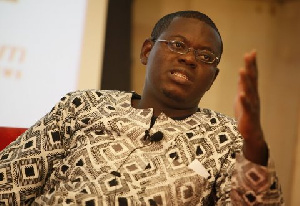Opinions of Monday, 26 March 2018
Columnist: Bright Simons
Is ‘execution’ really everything?
If you visited Wikipedia right this moment and pulled up the article on ‘Adinkra’, you would be told that the Adinkra motifs were originally invented by the Asante.
This intriguing factoid has had me musing for much of today. There are some interesting insights to be drawn from it.
Firstly, anyone with even the slightest interest in Asante history would find the claim amusing, even if perhaps wistfully so.
No, the Asante did not invent Adinkra. Adinkra was a symbolism that dates to the older Akwamu-derivative Kingdom of Gyaman. A Kingdom that lay astride what became Ghana and the Ivory Coast. Its grander half is probably in the Ivory Coast today.
The Gyaman Kingdom in the 18th Century came to lie between two powerful emergent empires, the Kong (created by the storied Ouattaras, believed to be scions of the even more glorious, by then defunct, Malian Empire) and the Asante. It was both the fortune of the Gyaman and also their misfortune that this made them an entrepot for the incredibly lucrative kola and ivory trades. Kola was one of three main currencies in Asante, and increasingly a vital part of its geo-economic currency policy.
Opoku Ware Tenten, the successor to Osei Tutu Opemsou, outmanoeuvred other powers in the region and sent forces to guarantee Asante suzerainty over the Gyaman and the entire Tano basin. The ostensible justification was a rumour, perhaps instigated by the Asante Court itself, that Gyaman had made for itself a Golden Stool as the personal property of Gyamanhene Abo Kofi. Having slain the Gyamanhene, the Asante imposed a garrison to maintain the free flow of trade. (Virtually all of Asante’s major wars were geo-economic in nature, involving the control of or strategic access to major trade routes).
It is at this point that the story gets interesting. For Gyaman actually learnt to play the diplomatic game well, and for half a century it flourished quite spectacularly. That is, until the rise of the War Party in the Asante Court.
Osei Kwadwo Okoawia, Asantehene, watched alarmingly as Gyaman actively courted the Sultan of the Kong and as the wealth of what was nominally a vassal state begun to grow tremendously. Gyaman was at one point so flush with ivory that it is said that Osei Kwadwo’s early plans of building a palace in Dwabirem, Kumasi (near Pampaso, where the military fort museum today rests), mounted on ivory frames (a feat later executed by the time of Bowdich’s expedition by successive Asantehenes) was driven by earnest accounts by traders from Bono.
It was in this state of national pride that Kwadwo Adinkra Ababio became Gyamanhene. And it was he who elevated the art of Adinkra from an obscure craft into the deeply mystical symbolic form it is known today. Some believe that this was the early stages of a written script (perhaps similar to what the Bamum script became in Cameroon nearly a century later).
Unfortunately for Kwadwo Adinkra, he peaked at the time when the War Party was firmly in control of the Asante Government, and at a time when the quality of Asante generalship was at its zenith, never to be surpassed. On the Osei and Poku stool sat Otumfou Osei Tutu Ababio Kwame Asibe himself, also known as Bonsu, the Whale. The Asantehene whose impression on the Europeans cemented their tradition (dating from Okoawia’s era) of calling every Asantehene, ‘Sai’, ‘Say’ or ‘Zaay’ (a corruption of ‘Osei’), much in the same way that the Kings of Ancient Egypt are referred to as ‘Pharaoh’. For Osei Bonsu was a thoroughbred warrior-king.
Now add to that, the combined might of Opoku Frefre (the gun-breaker) – Gyaasehene, Amankwa Tia – Kontihene, Kwaakye Kofi – Asafohene, and Adum Atta – Adumhene. And what do you get but the Porcupine unleashed in all its ferocity.
Needless to say, the Gyaman Kingdom, the greatest of the Bono States, at least since the 13th-century splendour of Bono Manso and Tekyiman, was completely crushed. Once again whilst the real reason was the control of the kola trade, the ostensible justification was that Kwadwo Adinkra had crafted for himself a golden stool. The offensive object was melted down and cast into funeral masks, using the skull of the slain King, which today hang on the Asante golden stool.
But then a curious thing happened. According to tradition, the eldest son of Adinkra, Prince Apau, a master weaver and undoubtedly a genius of the first class, was under hemlock forced to reveal his father’s hidden collection of Adinkra and other masonic-like mysteries. He was brought to Kumasi where he was put to task converting the prized ‘intellectual property’ into a form worthy of the Asante Empire as a whole, and its pan – Gold Coast aspirations. In such ways does imperialism sometimes express itself as an objective amplifier of the noble regardless of actual origin. In fact, in the half-century that followed, Asante power will carry the Adinkra motif from the Savanna, through the forest, to the very rocky forts of the Coast of what would become Ghana.
Why do we today remember Asante for Adinkra rather than Bono? And what does that tell us of our ideas of ‘accomplishment’?
Some people like to say that ‘ideas are nothing, execution is everything’. Yet, one can hardly deny that Kwadwo Adinkra executed. He did more than a prototype. His contemporary fame was certainly a partial outcome of his flamboyance and creative spirit.
It turns out that ‘execution’ is not enough. True domination of a domain or field comes from PROPAGATION. One must be seen as the dominant idea’s most ferocious exponent to become identified with it, in a crowded marketplace of attention.
Take Elon Musk. He neither invented the domain of mass-produced electric cars nor has he really proven its business model through flawless execution yet. He has taken over the public imagination and become the dominant motif of the very notion of a viable electric car industry and lifestyle because he is its chiefest propagator today.
So to repeat, sometimes Execution is not up to it. Propagation is everything.
By: Bright Simons
brightsimons.com











